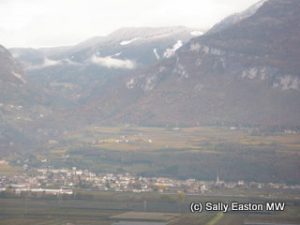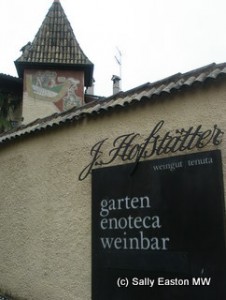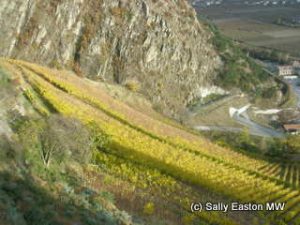Alto Adige pinot noir
Pinot noir accounts for less than 7% of the Alto Adige vineyard area, not quite 350 hectares. Even so it is still considered a core variety for the region, having been first planted here in the mid 19th century.

Mazon
Pinot noir is one of those grape varieties with an abundance of names. In Italian, it’s called pinot nero, in German it’s spätburgunder. But it’s also called blauburgunder in German, and in Alto Adige this is often how it’s referred locally, though not necessarily on the label, especially for an international audience.
Mazon
One of the most highly regarded sites for pinot noir is the Mazon (Italian: Mazzon) plateau. This is in the relatively warmer southern part of the region to the east of the river Adige, on west and south facing slopes, with some cooling elevation from 350 to 450m.
Weingut J. Hofstätter, in Tramin/Termeno is well-known for it pinot noir, which now accounts for about 20% of their production. Markus Heinel, winemaker since 2001, said the Mazon side of the valley “is cooler, you get the soft sun in the afternoon. There is a layer of porphyry and sandstone which is very good for the minerality of the wine. The altitude keeps the acidity on that cooler side of valley, ripening is slower and later than our side of the valley [at Tramin]. We have pinot noir and pinot blanc.”
The top Hofstätter pinot noir is named after Ludwig Ritter Barth von Barthenau who brought pinot noir to Alto Adige from Burgundy and planted it around Mazon in the late 19th century. The estate was acquired by Foradori- Hofstätter family which has given them access to old vine fruit. The fruit from 60 year old plus vines is reserved for the Barthenau Vigna San Michele pinot noir.

Hofstätter
Even the basic Hofstätter pinot noir uses some fruit from the Mazon plateau, and is labelled after the historic name of the Mazon hamlet – Meczan.
Mason
Just up from Tramin/Termeno is another producer aiming to make pinot noir one of their specialties. Tenuta Manincor is located in Kaltern/Caldaro, and owner Michael Goëss-Enzenberg said: “our pinot noir comes from Mason at 400m altitude. In our country pinot noir needs high elevation because we have a warm Mediterranean climate on south-inclined vineyards.”
Manincor’s Mason is named after their vineyard on the Kaltern side of the valley, the opposite side from the Mazon plateau. In particularly good vintages they make a Mason di Mason. Goëss-Enzenberg said the aim for his pinot noir is ”deepness and delicacy and elegance. We want to have elegant pinot noir fruit, very pure and persistent fruit that draws you back in.” And, he added, “we replanted 15 years ago to newer clones and trellising” as part of his quality drive.
Thirty years ago the property sold its wines in bulk and Goëss-Enzenberg has been turning the estate around, having trained at Geisenheim in Germany, and Babcock Winery in California.
Vinschgau/Val Venosta
In the far northwest of the region lies Val Venosta, an upstream extension of the Adige river as it flows in an east-north-easterly direction, before turning south-east towards Merano and on to Bolzano. Here vineyards are on the south-east facing slopes, with a bit more altitude, from 500 to 800m. And here, pinot noir has recently been becoming something of a specialty.

Unterortl
This is something of an extreme viticultural environment. The vineyards of Weingut Unterortl lie on steep south facing vineyards, 600 to 850m above sea level, amid rocky outcrops. Their general manager, Martin Aurich, said the area is “high and open to the valley, it’s open to glaciers and open to cold climate,” adding “the wines have a mineral character because of their high content of acid.” Harvest here is two weeks later than the main Adige valley.
Pinot noir is grown with pinot blanc and riesling. Aurich said: “the quality is regular, but the weather and the wind can dry out the grapes. If the sugar became much higher it would become bitter. We have the elegant point for pinot noir. Pinot noir is not a tannin monster, we have a sweet tannin that can be aged.”
Whilst pinot noir undoubtedly specifies a cool climate for its best expression, the winemaking approach is important not to lose the potential. All three producers here use a varying dose of 225 litre barrique, with up to a third mentioned as being new. They also use big oak, from 500 to 5,000 litres, which imparts only a little, if any, oak flavour and tannin. All of them are aiming for long-aged pinot noir.
Tasting notes, in situ, November 2009
Hofstätter, Crozzol Pinot Nero 2007
Pale ruby colour, bright and attractive, with aromatic smoke and toasty oak. Sweet attack, falling into fruitiness. Bright, crunchy fruit, neatly focused and elegant.
Hofstätter Mazon Pinot Nero 2007
Translucent ruby; savoury, tar nose, with toast and spice. Phenols a little bit chewy in youth, with plenty of vibrant fruit mid palate. Nicely balanced mid palate, with a purity of redcurrant fruit running through the whole.
Hofstätter Barthenau Pinot Nero 2007
Not yet on the market. Translucent medium ruby colour. Deep, pipe-tobacco smoke nose, full bodied and a hint balsamic still as the rich fruit is still absorbing the oak.
Hofstätter Barthenau Pinot Nero 2004
Rim just turning away from youthful cherry. Sweet stewed berry attack leads into a lush-textured mid palate of lovely balance and dimension. Youthful.
Hofstätter Barthenau Pinot Nero 1998
Garnet rim with a nose of mature undergrowth. Palate shows stewed cherry fruit with a savoury/sweet combo undergrowth finish. Elegant, silkily textured; really very classy.
Manincor Mason Pinot Noir 2007
Pale ruby, fruit focused palate, clean and define. Fresh cherry with new oak peeking over the youthful fruit.
Manincor Mason di Mason 2007
This comes from the heart of the vineyard, oldest vines now 15 years. Only made in the best vintages.
Medium translucent cherry colour. Violet perfume; fruit a bit subdued due to recent bottling, but texture, weight and density are all refined, with lovely balance.
Unterortl Castel Juval Blauburgunder/Pinot Nero 2007,
Medium pale translucent cherry colour. Aromatic strawberry nose, both spicy and lightly toasty, with a complexing tar note. Strawberry and redcurrant fruit is putting on a bit of weight in bottle, with poise to come.
Loacker Pinot nero 2007 Norital
Medium translucent ruby colour. Vibrant black cherry nose, with hint of tar at beginning of the quite full-bodied palate. Attractive varietal definition of warm cherry fruit, currently a little subdued by still-integrating toastiness.
This piece was inspired by a visit to the region in November 2009 sponsored by the Italian Trade Commission (ICE) and EOS, the export organisation of South Tyrol.



